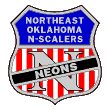An Operationally Oriented, Fully Functional Passenger Terminal and Service Yard in N-Scale
Riding on a passenger train is the experience most people remember about a railroad and above all else, that experience leaves a lasting
memory of an individual's personal interaction with trains. Sure, folks see freight trains on the tracks and get frustrated when having
to wait while a local freight performs switching operations and blocks the street for twenty minutes, but the glamour and passion of the
rails lies in the passenger train, the kind of train in which everyday people actually have ridden.
Download complete Micropolis Passenger Yard Plans
Micropolis Passenger Yard Introduction
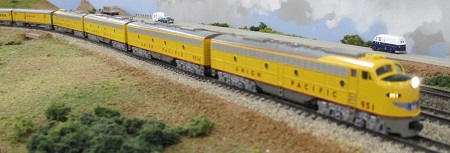
Union Pacific's City of St. Louis runs through Tourist Trap
on its way to the Micropolis Yard.
Often overlooked and seldom appreciated are the details of passenger train operations. Operating a passenger train can involve much more that
coming out of staging, making a lap of the layout with a few short station stops, then returning to staging. Modeling the support
infrastructure of a full service passenger yard can be an interesting and rewarding adventure and the result of that effort can provide an
operating experience that is unique, enjoyable and challenging. Just like freight trains, passenger trains have an origination site, make
car drops and pick-ups along their route, and have a final destination. At each end of the route the train must be either assembled or
broken down and the cars must be serviced, inspected and made ready for their next trip. In the real world each individual car in a passenger
train requires attention since it must be kept clean and fully functional at all times. Additionally, one must remember that, besides people,
passenger trains also carry freight. Freight not only includes baggage, mail and Railway Express Agency (REA) shipments, but also food and drink. On top of that,
passenger trains have a staff of porters, cooks, and other personnel onboard at all times to support diners, sleepers, restrooms, lounges and
all the other amenities that are needed to provide a pleasant and enjoyable journey for every passenger.
Just like what was prototypically seen in many larger cities, the Micropolis passenger train complex is in or adjacent to the downtown area of
the city it serves and has its coach service yard nearby, but in a more industrial area that has less valuable real estate. Since this design
represents service to a large metropolitan hub city used by several railroads, it has a passenger terminal facility rather than a pass through
station. It is a complex of four separate but coordinated operational areas: the terminal facility, coach yard, locomotive service and ready
yard, and approach / staging area
Passenger Terminal Area
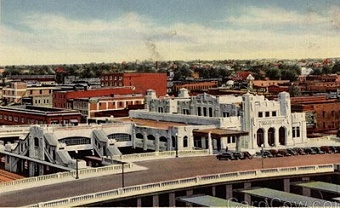
Tulsa Union Depot
The passenger terminal area has six tracks plus a special track for Pullman sleeper cars. The Pullman sleeper car tracks allow passengers with
late evening or nighttime departures to board their car earlier in the evening, well ahead of the normal boarding time, and retire for the night.
Similarly, Pullman sleepers on very early arrivals are moved to the Pullman track so passengers can sleep in and don't have to rise in the middle
of the night to disembark. Each 2400 scale foot track is long enough to hold a 20+ car train along with its head end cars and engines and has a
25 scale foot wide platform on each side along its entire length. The station's tracks are covered by a train shed that extends the entire
length of the platforms, protecting the area from inclement weather. Adjacent to the tracks are four USPS mail car tracks and three Railway
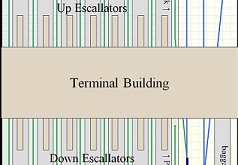
Passenger Terminal Area(click to enlarge)
Express Agency tracks. The terminal and shed area is 16' long (nearly 1/2 scale mile) and the yard throat and ladders extend another 8'.
Add to that the yard approach tracks, the locomotive service area and the cutoff that connects the terminal to the coach yard and the total
length is 40' (nearly one and one quarter scale miles.) The terminal, throat and locomotive service areas are 2.5' wide and the approach tracks
area is 2' wide, but could be reduced to less than 1' wide. The entire complex connects to the main line at a 90° curve in the main that acts as
two legs of a wye. Trains must make the curve, throw the switch, and then back into the passenger complex.
Coach Yard
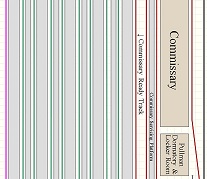
Coach Yard(click to enlarge)
The coach yard is parallel to the terminal area but separated by a 4' wide aisle so operators can work back to back without bumping into each
other. A 2' x 6' and a 2' x 4' "L" shaped section connect the coach yard to the approach area. The 12' long yard has another 6' for its ladder
tracks and throat resulting in a total length of 2880 scale ft. It is 36" wide. There are ten 12.5' (2000 scale foot) long yard tracks for
railroad owned equipment, each track with a 19 to 20 car capacity. Service platforms bracket each track, a narrow one (10 scale ft wide) on
one side for foot traffic and a wider one (20 scale ft wide) on the other side to handle carts and other equipment. Steam, electricity compressed
air and waste disposal ports are positioned along the narrow platforms so each car can plug in as required At the stub end of the service tracks
is a large building that houses the many and varied trades needed to support a passenger fleet. These departments include housekeeping, laundry,
carpet, upholstery, plumbing, electrical, mechanical, and other services.
Pullman owned and operated cars are pulled from the consist and are serviced at their own adjacent two-track area with a 3' long (500 scale ft)
platform between the tracks. The Pullman area contains a warehouse, a linen / laundry building and a dormitory/locker room for porters. A siding
on the back side of the warehouse and laundry provides space for loading and unloading supplies from box cars. Once Pullman cars are serviced,
they are stored on the Pullman ready track until needed. The two service tracks can each hold six cars and the ready track can store ten cars.
Dining cars are relocated to the two commissary tracks for servicing. A 3'+ long platform (520 scale ft) runs between the two tracks. Each track
can hold six dining cars. Along the back side of the commissary building there is a supply track for reefers and other cars carrying needed goods.
On the other side of the coach yard is the car inspection and repair pit. In passenger service safety is a top priority and therefore the
undercarriage of every car is routinely inspected. When the terminal switcher drops off the remaining cars of the train on the coach yard
transfer track, the coach yard switcher immediately takes those cars to the coach yard inspection pit so that they can be checked out. This
inspection includes trucks, wheel sets, brakes, couplers, linkages, air and steam lines and connections, etc. Cars with defects are moved to
the adjacent repair track and the rest are moved to a specified service track. Between the inspection area and the service tracks are three
coach storage tracks where up to 27 spare cars and privately owned business cars can be kept until they are needed.
Train Operations
As soon as a train arrives at the terminal, the locomotives uncouple and move to the locomotive yard for servicing. These services include fuel,
sand and water. If an engine requires repairs or other services it must travel to the nearby freight yard where those services are available.
Once serviced, the locomotives are placed on one of the eight ready tracks until needed. This complex is a division point, so crews are changed
out. The passenger complex requires two switch engine pairs to move and spot cars. These engines are stored on two sidings at the locomotive
service yard.
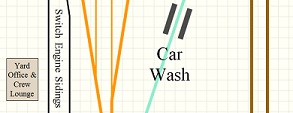
Locomotive Yard(click to enlarge)
The entire complex is designed at maximum size to accommodate any and all features that would have been found in passenger service yards during the
hey-day of passenger service during the 1950s. They are designed in N-Scale and are modular with an interface that can connect to an N-Trak
junction module and become part of a large N-Trak layout. An examination of track plans for real yards of this era will show an intricately
woven nest of tracks, with double slip switches, crossovers and three-way switches that worked well in full scale, but can cause problems when
model cars have to back over them. For that reason, the yard ladders are simplified, sacrificing complexity and compaction for ease of operation.
Obviously, the design is flexible. The coach yard can be turned 90° or to any angle desired, and the service yard and approach area can also head
off at any angle. It is easy to shorten the terminal and coach yard areas and the approach tracks don't have to be straight. Nor does the complex
have to be modular or even N-Scale. This is a blueprint that one can customize to fit the concept and space requirements of the modeler.
Operationally, the Micropolis Passenger Yard is designed for a four man crew plus the operators of arriving and departing trains. These four
operators work as two 2-man teams, one team at the terminal facility and the other team at the coach yard. Heavy lines in the diagram indicate
main traffic flow routes that should not be blocked, thereby allowing for free, unobstructed movement to all areas of the facility. Design
geometry is based on Peco long turnouts throughout. The digital image of this design has a background grid that clearly defines all measurements.
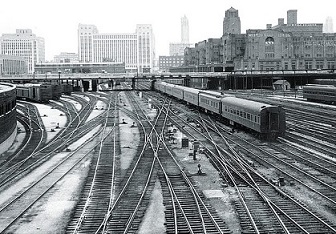
Intricately woven nest of tracks
Although a beautiful and picturesque component, the train shed must be removed during operating sessions to allow access to cars under the shed.
Once the train is backed into its arrival track, the road crew uncouples from the train and moves the engines to the locomotive yard where they
turn the engine over to the hostler and then head to the crew lounge until called for an outbound train. The Terminal crew, with one person on
each side, breaks down arriving trains, moving the REA and RPO cars to their respective areas, and delayed de-boarding Pullman cars to the Pullman
standing tracks. When the appropriate time has passed, these Pullman cars must be sent to the coach yard Pullman tracks. The remaining cars are
pulled from the terminal tracks and pushed over to the coach yard. Similarly, departing trains must be assembled. One hour before scheduled
departure, the main consist will be picked up at the coach yard, pulled down the red departure track, then backed through the wash gauntlet and
onto its assigned terminal track. Early boarding Pullmans will then be attached along with baggage and REA cars. Finally, RPO cars will be added
and the engines will be moved from the engine ready tracks and coupled to the train. As time permits, REA and RPO cars must be shuffled to and
from their working tracks to their ready tracks.
The Coach crew, again with one person on each side, finishes the breakdown of a train once it has been delivered from the Terminal. First, all
cars are run over the inspection pit and any cars with problems are left there. Then all Pullman cars are sent to the Pullman tracks, dining and
lounge cars are sent to the commissary tracks and the rest are returned to a yard track for servicing. Once serviced, they are either moved to
the coach storage tracks until needed or left on the yard track for use later in building an outgoing train. Two hours prior to a train's
departure, that train's consist is assembled in the order required, drawing the observation, dining and/or lounge cars from the commissary
tracks, coaches and sleepers from the idle coach tracks, and Pullman cars from the Pullman ready track. Early boarding Pullmans should have
already been sent over to the terminal Pullman standing tracks. One hour prior to departure, the Terminal crew will pick up the assembled consist
from the coach yard. Additional crew duties include shuffling cars in the commissary and Pullman areas between the platform tracks and the ready
tracks and returning repaired cars from the inspection area to the service area.
Occasionally a transfer freight will enter the complex to pick up and/or deliver coal hoppers to the power plant or locomotive service tracks,
reefers to the commissary, box cars with supplies for the Pullman, commissary or general service areas, tank cars with diesel or oil and hoppers
with sand for the locomotive service tracks, and flat cars and box cars with trucks, wheels and parts for the car repair area. The Coach Yard
crew will spot the arriving cars and deliver any empties to the transfer freight engine crew.
Optionally, a fifth operator can be used as the yard master, coordinating and scheduling all activities within the complex.
Remembering that this design is made to be N-Trak compatible, that the approach tracks connect to the N-Trak red line as part of either a left-hand
or a right-hand junction module and that the red line is usually operated in a counter-clockwise direction, then the approach legs which a ccw
running train would not normally use would be the legs that much switch polarity. This section of track only needs to be as long as the longest
engine consist unless you run a train with track powered lighting in the cars. In that case, the reversing section must exceed the total length
of such a train. All tracks in the complex other than the reversing section should be wired with the left rail receiving the positive feed and
the right rail the negative.
Download complete Micropolis Passenger Yard Plans



